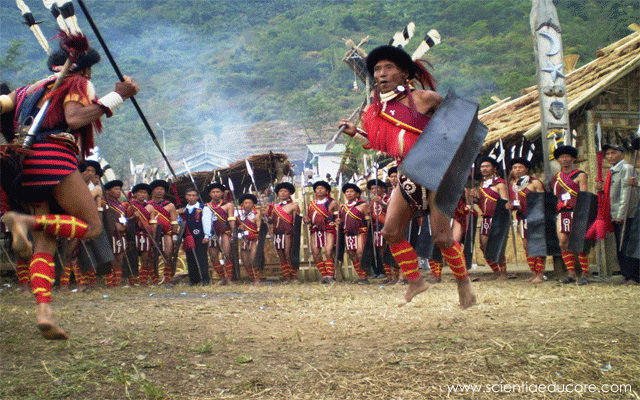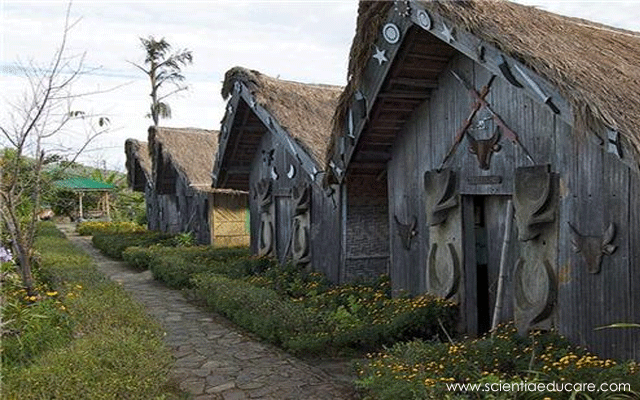
Ranakpur Jain Temple, Ranakpur
One of the finest examples of the Maru-Gurjara Architecture, The Ranakpur Jain Temple is located in Pali district of Rajasthan. The temple was constructed in 1437, under the patronage of the Maharana of Mewar. The temple is constructed entirely in white marble and adorned with elaborate carvings.
The Chaturmukha Jain Temple of Ranakpur In the heart of the remote and enchanting valley of the Arvallis, skirting the rivulet Maghai and enveloped in the solitude of the surrounding forest, stands, in solemn grandeur, the Chaturmukha Jain Temple of Rishabhadeva. Placed on a lofty plinth, the three-storeyed marble edifice, to which the genius of the artist has imparted exquisite artistic grace, and which his deep devotion has endowed with serene spiritual dignity is, verily, a poem in stone. Majestic yet in complete harmony with Mother Nature, in whose beautiful lap it rests, this magnificent monument of devotional architecture seems bathed in celestial bliss. The very hills around, dwarfed by its imposing bearing, appear absorbed in mute meditation, as if spell-bound. The concord achieved between the bounteous generosity of Nature and man’s creative expression of gratitude, stands uniquely symbolised in this Divine Creation. To behold this holy shrine in its spectacularly sublime settingis to experience instant uplifting of the soul.
Rajasthan is famous for its rich and prolific art treasures. Some of its architectural monuments are considered among the best in the world. The Ranakpur Jain Temple excels them all as an exquisite work of art and architecture. There are a number of beautiful and delicately carved sculptures in this shrine which defy comparison. The temple is an eloquent testimony to India’s cultural heritage, her unique architecture and the vision and acumen of her past master artists.
This temple is the realiation of the vision and endeavours of four great and devout seekers They were Acharya Somasundatsuri Dharanashah, the Minister to Kumbha Rana, Rana Kumbha himself, and above all, Depa or Depaa, the architect who made the realisation of the dream possible.
Acharya Somasundarsuriji was a magnetic personality who lived in the fifteenth century of Vikram Era. Shreshti Dharanashah belonged to the village Nadia near Ranaipu From here he had migrated to Malgadh. His fathers name was Kurpal and Kamalde was his mother. He had an elder brother named Ratanashah. They had descended from the illustrious portual clan. Dharanashnh came into contact with Acharya somasundarsumi who infused a strong spiritual urge in his heart. At the age of thirty-two, when he visited Shatrunjaya, the foremost among all the places of Jain pilgrimage, Dharanashah tonk the austere vow of lifelong celebacy. Aided by his sharp intellect, a keen administrative power and an innate capacity to lead and govern, he had risen to the position of a Porwal Kumbha Rana. one blessed moment Dharanahah felt the spontaneous urge to build a temple of Lord Risabihadeva, which he resolved, should be without parallel in beauty. A legend tells us that one night in his dream. Dharanashah had a vision of Nalinigulma Viman which is considered to be the most beautiful among the celetal planes. Dharanashah decided that the temple should resemble this heavenly Viman
He invited many renowned artists and sculptors They submited their plans and designs, but none could even remotely capture the Minister’s dream image. last an easy-going sculptor named Depak from Mundara presented a plan, which simply thrilled the heart of Dharanashah. He was profoundly impressed. Depak was a carefree type of an artist and would prefer poverty to servility. He set very high value on his art. He was deeply touched by the transparent personality and devoutness of Dhararashah. He promised to create a temple which would give concrete shape to the Ministers dream. And thus, a rare confluence of art and devotion was effected by the two visionarie. Dharanashah approached Rana Kumbha with a request to give some land for the construction of the temple. The king not only gave the land but advised Dharanashah to build a township also near the site. The site of the old village Madgi in the valley of Mount Madri was selected for the purpose. The construction of the temple and the township began simultaneously. The town was named Rampur after the name of King Kumbha Rana. Ranpur is popularly known as Ranakpur
The construction of the temple which had begun in 1446 Vikram Samvat, could not be completed even after fifty years. Dharanashah, considering his advancing old age and failing health, decided to install the idol of the Principal deity without much loss of time. In the year 1496 of the Vikram Era, after the completion of the temple, the idols were ceremoniously installed by Acharya Somalsundarsunii. At last, hard work and devotion of some 50 years brought the Minister’s dream down to earth in the form of a magnificent temple. an image of the Viman of the gods. One cannot but feel awe and reverence for the ingenuity and craftsmanship of this gifted artist. According to one legend, about ninety-nine lakhs of rupees were spent on the construction of the temple. It is believed that the master builder Depa had put the devotion of his patron Sheth Dharanashah to test by making him offer seven precious metals, pearls, rich stones, musk and other fragrant substances while laying the foundation. In spite of the complexity, the vast expanse and the loftiness of the temple, the architectural balance and symmetry are not the least affected. The artiste sculptures which lie scattered like precious jewels, the myriad ornate Toranas’ or festoons with minute and delicate carvings, the innumerable elegant and lofty pillars and a large number of Shikharas, (spires) which make a unique pattern on the face of the sky-all these works of spiritual art, as one approaches them, become alive and make the beholder oblivious of all else but a feeling of ecstasy, as if touched by the sublimity of Divine Bliss
The temple has four artistic entrances.In the main chamber or Gabhara (Sanctum sanctorum) of the temple there are four huge white marble images of Bhagvan Adinath, These four images, which are some 72 inches tall, have been installed facing the four different directions. In the sanctuaries on the second and third storeys also are enshrined four identical Jain images. it is because of these four imaages nstalled together in this temple, that it is popularly known as Chaturmukh Jain Temple In addition to Chaturmukh Prasad this temple is also known as Dharan Vihar, Trailokya Deepak Prasad or Tribhuvan Vihar. Dharan Vihar is a suitable name because it was built by Shreshthi Dharanashah. It stands like a luminous light spreading radiance in all the three Lokas (spheres) so it could be aptly called Trailokya Deepak Prasad or Tribhuvan Vihar. All these various names speak of its great glory.
Besides, seventy six smaller domed shrines, four Rangamandapas (assembly halls), four Mahadhar Prasads (Principal Shrines) situated in the four directions, a number of big and small Devakuikas (subsidiary Shrines)-in all 84 in number stand embellishing the temple, soliciting and inspiring man to strive for emancipation from cycles of 84 lakhs of birth and death and attain eternal salvation. The four ornate Meghanada-mandapas are unique in their sculptural beauty. The forty feet high pillars bedecked with delicate carvings, the artistic Toranas’ or festoons suspended like ornaments studded with precious stones and the magnificent dome with its delicately carved pendant simply keep one’s eyes glued to them. One feels as if the very core of the stone has not been left untouched by the artist’s chisel. The radiant images of the goddesses in the dome hold the beholders spell bound, with their hearts athrill with expectancy. Judging from Meghanada mandapa alone, one cannot but feel that the creator must have been much more than a great artist indeed a weaver of dreams
Looking at the image of the Lord from the Meghanada mandapa, makes one realize how insignificant and imperfect one really is before his infinite Creator inspiring one to rise above false pride and ego and to become aware of one’s true place in the Divine scheme of things, while entering through the West Meghanada mandapa one sees on the left hand side pillar, the carved images of Dharanashah and Depak facing the Lard. They too seem to. remind man of his humble position before God. How could one not bow down in reverence before these two great soul the Minister for his artistic devotion and the artist for his devotional art. The domes and ceiling of this temple are replete with innumerable carvings depicting famous incidents from the past. The artists have given them life and movement with the magic touch of their chisels. While trying to comprehend their mute language, the beholder becomes oblivious of time and space, marvelling at the workmanship. The stone-slabs depicting sahasrafana (a cobra with thousand hoods) Parshwanath and sahasrakuta are equally impressive.
The most outstanding feature of this temple is its infinite number of pillars. This temple can be called a treasure house of pillars or a city of pillars. In whichever direction one might turn one’s eyes meet pillars and pillars big, small, broad, narrow, ornate or plain. But the ingenious designer has arranged them in such a manner that none of them obstructs the view of the pilgrim wishing to have a Darshana’ (glimpse) of God. From any corner of the temple one can easily view the Lord’s image. These innumerable pillars have given rise to the popular belief that there are about 1444 pillars in the temple.In the North of this temple, there is a Rayan tree (Mimusos laxandra) and the foot prints of Bhagavan Rishabhadev on a slab of marble. They remind us of the life and preaching of Bhagavan Risabhadev and of Shatrunjaya, the foremost among the places of Jain pilgrimage.
on one hand the temple has been made artistic with it’s two upper storeys, on the other the designer has shown foresight in constructing some nine cellars in which the sacred images could be safely preserved in the event or a crisis. It is believed that there are many Jain images in these cellars. These cellars must be an additional streng and support to the entire structure and must have sustained it against the onslaught of time and the elements The Jain temples of Mount Abu are famous for the carvings, but the Ranakpur temple also is second to none in its delicate carvings. What attracts one most is its complexity and vast expanse of its structure. There is a popular saying among the people: The canings of Abu and the architecture of Ranakpur are unique”. The eroding sweep of time and nature and wanton and mindless destruction by foreign invaders did much damage to this holy shrine. For a long time it wore a deserted look as pilgrims didn’t find it safe to go to this secluded place infested with wild animals and dacoits.
Ranakpur Fortunately, in the Vikram Samvat 1953 (1897 A.D.), the hole congregation-Shri Sangha-of Sadri, handed over the administration of this shrine to sheth Anandji Kalyanji Trust (Pedhi). Soon after taking over charge the Pedhi’ addressed itself to the primary task of providing amenities to pilgrims, and safety from the danger of wild animals. The authorities then launched an ambitious programme of renovating the temple. The renovation which had begun in the Vikram Year 1990 continued for eleven years and was accomplished in S. Y. 2001. The artists who set chisel to stone have lent such a delicate grace to this old structure that world-renowned architects and sculptors have lavishly praised it as one of the wonders of the world. This renovated shrine has once again attained its unique fame in the world of art and religion. Every year thousands of art-lovers and spiritual seekers from all over the world come to this idyllic place. They return amply rewarded. To meet the ever-increasing number of tourists, the Pedhi has constructed many new Dharmashalas (inns)’. Formerly there was just one old inn for the pilgrims. Now there are three new inns, which provide all modern amenities and comforts.
But the quintessence of this masterpiece is to be discerned in the fact that it was conceived as an image of the celestial Viman Nalinigulma and the materialisation of the image acquired an aura that makes the beholder feel transported to a dream-world, where he experiences the rare and divine magnificence of the heavenly Viman. If the sublimation of the mind and an experience of the bliss of the subtler and higher states of the consciousness is the purpose of art, the spirit of Art has undoubtedly been fulfilled in the Chaturmukha Temple.













